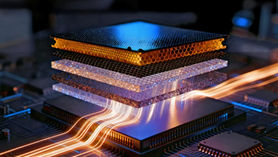Nanomaterials - the basis of emission-free energy of the future
- https://www.nanonewsnet.ru
- May 31, 2022
- 4 min read
Updated: Sep 24, 2022
The aggravation of the geopolitical conflict between Russia and Western countries gives a powerful impetus to the accelerated development of not only new power generation technologies that are not related to fossil fuels, but also energy saving technologies, as well as an increasing trend to abandon the use of vehicles with internal combustion engines.The creation of a power generation system based on alternative energy, primarily solar and wind generation, in practice has shown their critical dependence on weather conditions.

The progress that has been made in recent years in the field of creating new nanomaterials allows many scientists to reasonably assume that the energy of the future will be based on the use of nanomaterials both in the field of electricity production and in the field of its delivery to the consumer with minimal losses. The current electricity grids are limited in capacity in almost all countries and will not be able to cope with the sharply increasing demand for electricity. Modernizing the power grid will require significant investment: in the United States alone, investments will be required in the coming decades to upgrade obsolete power lines and build thousands of kilometers of new lines, which could reach $ 2 trillion, and given the current inflation, they can increase many times over.
The idea of creating a distributed power supply system based on the use of nanomaterials, which would allow converting the energy of surrounding radiation fields into electric current, is promising. The feasibility of such a promising idea was investigated by scientists from the Neutrino Energy Group under the scientific supervision of Holger Thorsten Schubart. The study of various materials to implement this idea began at the beginning of this century, and the first stable positive experimental results were obtained and made public in 2014. The difficulty was not only in finding the material and substantiating the principle of the appearance of an electric current, but also in the absence of a mental perception of the very fact of the possibility of obtaining electricity under the influence of surrounding radiation fields. Therefore, the creators of the technology and, first of all, Holger Thorsten Schubart, in their function of president and scientific director of the project, were forced to do a lot of information and explanatory work both in the scientific community and among the general population, rightly believing that such information would attract attention to the project and will not make it possible to ignore the fact of the existence of technology, increase the level of emphasis on technology and, ultimately, such work should have accelerated the start of the industrial production of current sources called Neutrino Power Cubes. The industrial production of Neutrino Power Cubes power sources with an output power of 5 kWh, intended for power supply of households, will begin in Switzerland in late 2022 - early 2023, and Neutrino Energy Group has also provided licensing rights for the production of Neutrino Power Cubes on a commercial basis to several countries, including Russia . License rights to Russia extend not only to the production of Neutrino Power Cubes power sources, but also to the production of electric vehicles with direct current sources built into the body of an electric vehicle, as well as to the production of the widest range of products using Neutrinovoltaic technology.

The know-how of Neutrinovoltaic technology lies in the invention of a nanomaterial capable of converting the kinetic energy of various particles of the invisible radiation spectrum, which have mass, into electric current. To be more precise, various radiations, including a stream of neutrinos with a power of 60 billion particles per second, penetrating every cm2 of the earth's surface, cause graphene atoms to vibrate. Vibrations of graphene atoms caused by particles of radiation fields are superimposed on vibrations of graphene atoms caused by thermal Brownian motion. When these vibration frequencies coincide, a resonance of vibrations of graphene atoms appears, which makes it possible to multiply the recoil of graphene electrons. In graphene, which has a six-sided crystal lattice as its basis, a wave arises, like waves on the surface of the sea, appearing as a result of a combination of small spontaneous movements and leading to the appearance of larger spontaneous movements. The displacement of one atom, summing up with the displacements of other atoms, causes the appearance of surface waves with horizontal polarization, known in acoustics as Love waves. The lighter the atomic mass of a chemical element, the stronger the effect of the collision of various particles with the nucleus of an atom of a chemical element. Presumably, this is why the vibrations of graphene atoms, for example, are 100 times stronger than the vibrations of silicon atoms. The process of interaction of neutrinos and other particles of radiation fields of the invisible spectrum with the nucleus of an atom of a chemical element is called "coherent elastic neutrino-nuclear scattering (CEvNS)".

Neutrino Energy Group scientists have found that by alternating layers of graphene with silicon and adding alloying elements, electrons in graphene distort their movement in a general direction, i.e. there is a constant electric current. The overall effect is what physicists call "oblique scattering," where clouds of electrons deflect their motion in one direction. A single layer of graphene is capable of generating a very low current, but the challenge was to create a technology that would work stably, and the direct current sources created on its basis would be compact. The problem was solved by making the generating nanomaterial multilayer, thus, the output current and voltage were increased many times over. The multilayer nanomaterial is applied to one side of the metal foil to preserve its integrity. The coated side of the metal foil becomes the positive pole, while the uncoated side becomes the negative pole. The presence of positive and negative poles on the power generating plate allows you to create power sources of various output characteristics.
The development of the Neutrinovoltaic power generation technology is undoubtedly a valuable scientific achievement, and its implementation in practice will be an important contribution to the creation of an autonomous non-emission energy of the future without a centralized power supply in the era of refusing to burn fossil natural resources for power generation.
Author: Rumyantsev L.K., Ph.D.





















































Comments